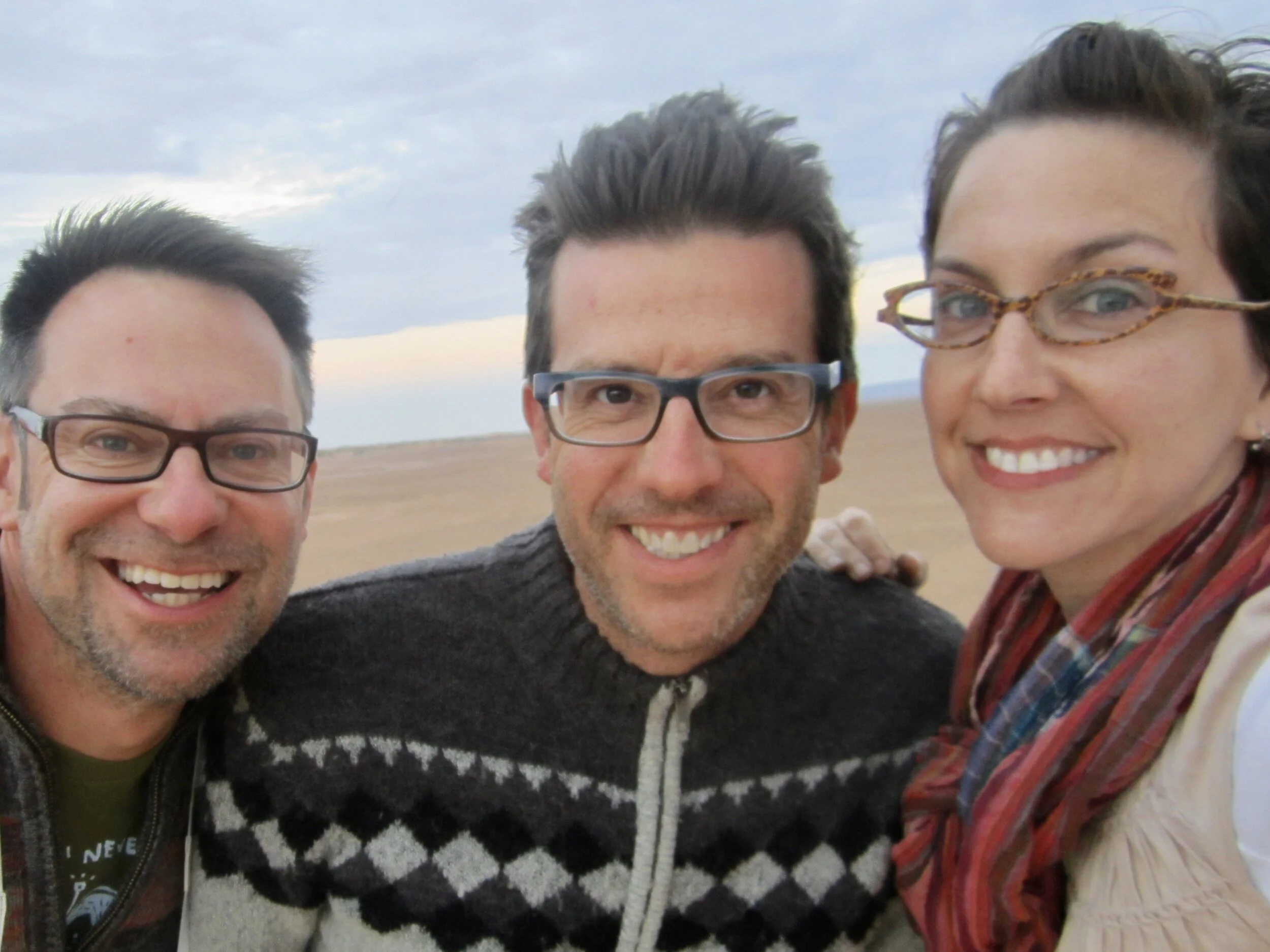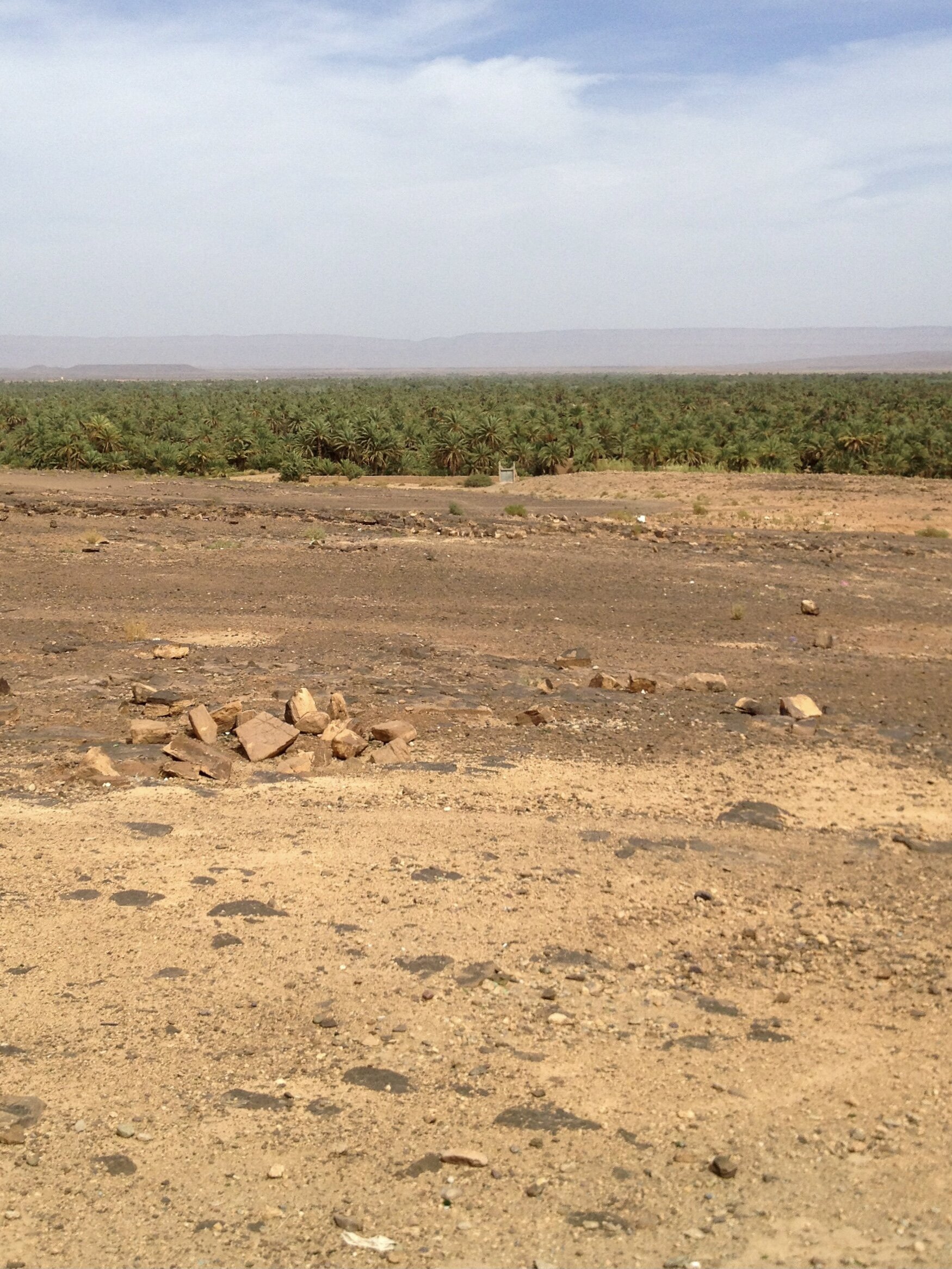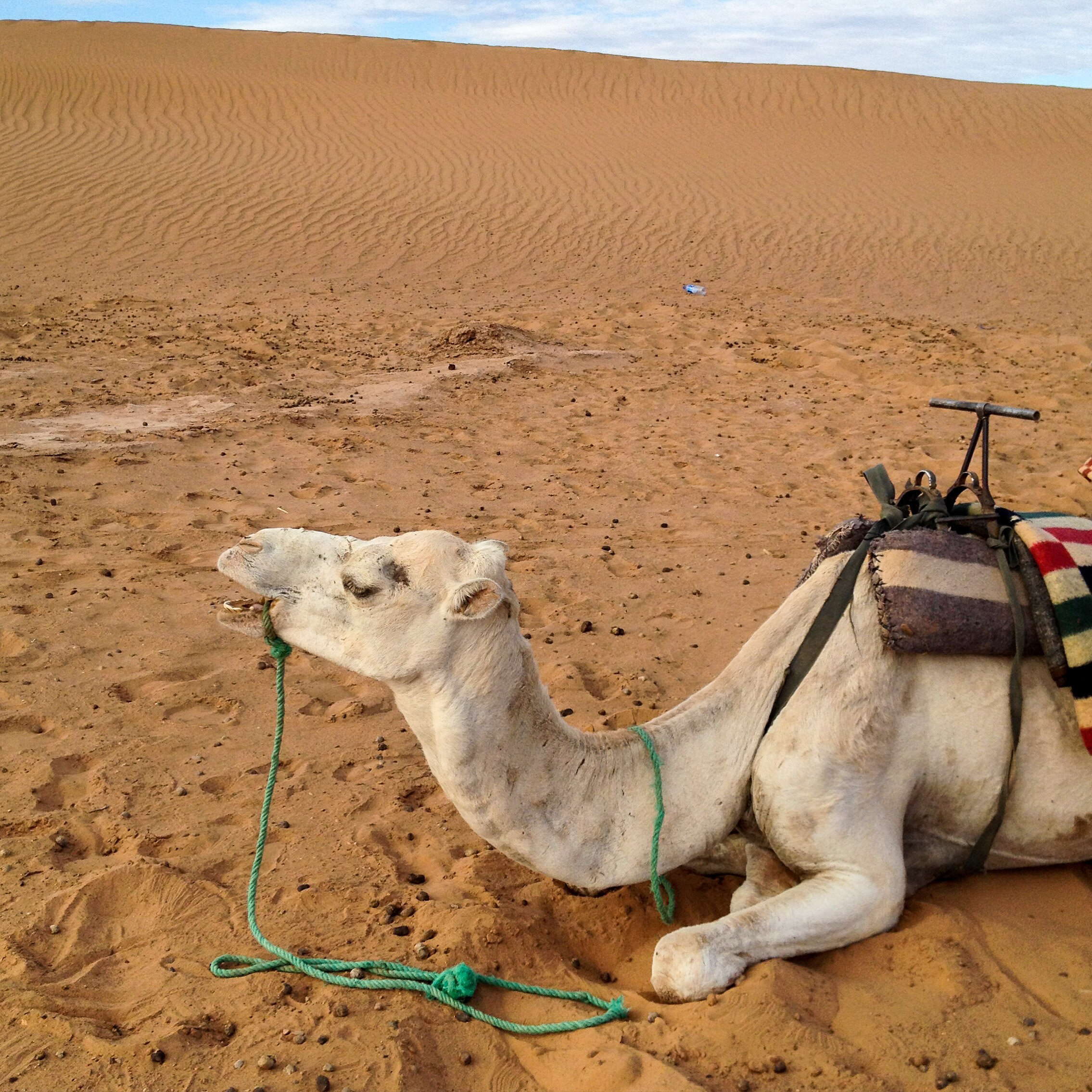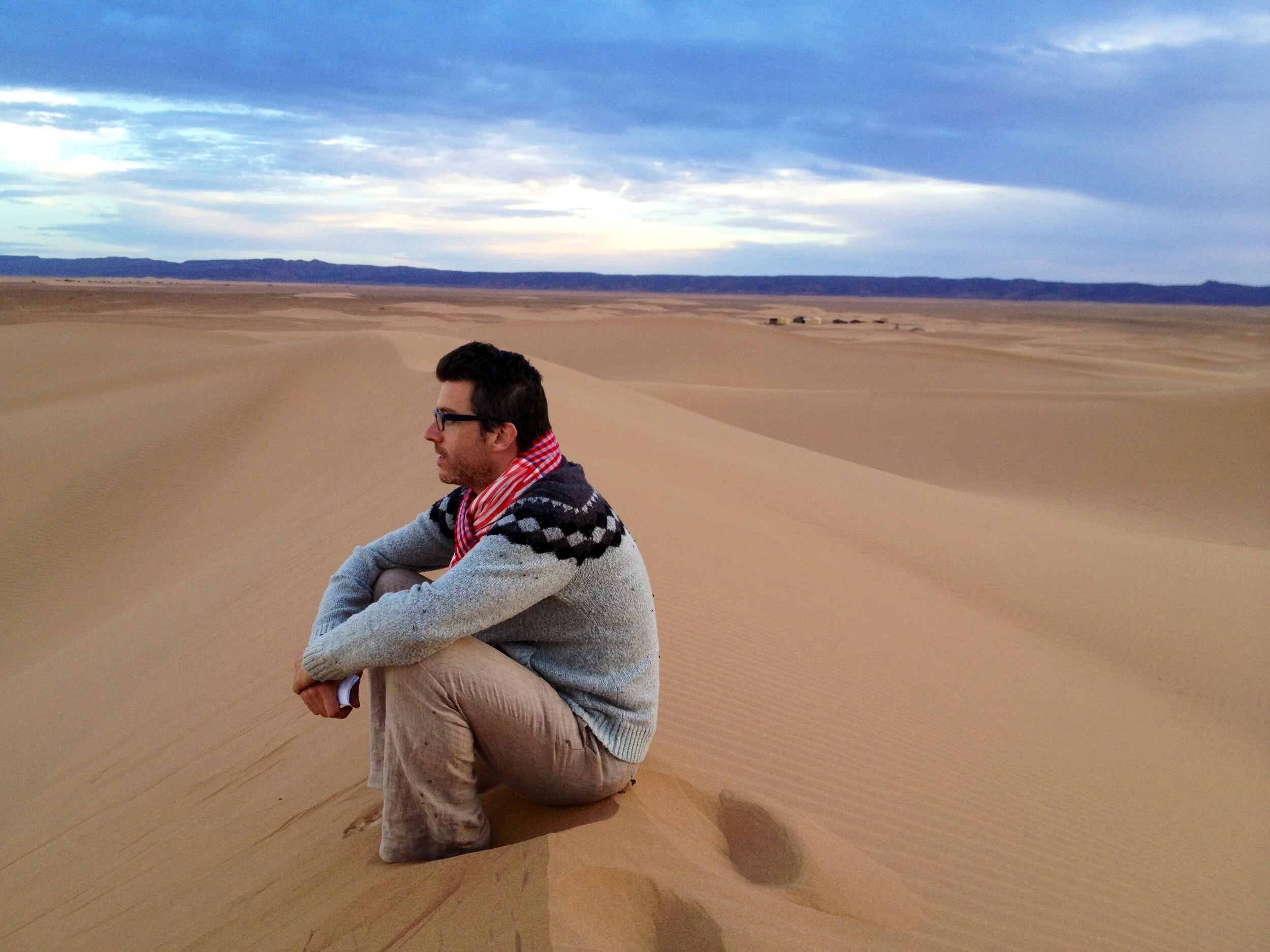No trip to Morocco is complete without a camel ride to a Berber camp at Erg Chigaga.
The tents are spacious and have carpets lining the walls to keep the warmth in.
There are some adventures that offer a one-of-a-kind experience that simply can’t be passed over. For Wally and me, an overnight at a Berber camp in the middle of the Sahara Desert fell into this category.
Besides, the road trip from Marrakech takes you to some amazing stopovers, including Atlas Studios and Aït Benhaddou.
“The camel was wide-eyed with fear or fury, rearing its head and making terrible Chewbacca-like warbles.
“Nous avons peur!” Wally exclaimed, which translates to “We are scared!””
Look how happy being in the beautiful and vast Sahara made Duke, Wally and Vanessa!
On the Road Again
After spending the night in Ouarzazate, Wally, Vanessa and I set out with our driver, Barak, to Erg Chigaga. Prior to our trip, we had debated at length whether to set off for the desert from Erg Chebbi or Erg Chigaga, and settled upon the latter — perhaps just because it sounded a bit like Chicago.
The landscape beyond Ouarzazate is covered with scrub and jagged rocks. Hillsides are mostly barren, covered with loose-looking boulders and thorny bushes. The rock color shifts from mountain to mountain — red ochre at first, then a sulfurous basalt green and finally a deep coal black. The large angular red rocks of the Anti-Atlas range jut out in a staccato formation like massive fallen Jenga blocks littering the mountainsides.
Unfortunately, even remote places like the Sahara aren’t immune to pollution. Disposable plastic bags of blue, faded rose, green, pale lavender and yellow littered the landscape like deflated balloons.
The Sahara isn’t an immediate vast expanse of sand — the first hour or so of our camel ride was over semi-rocky terrain with green outcroppings here and there.
Draa Valley: It’s a Date
We passed through Zagora, the last major town, 60 miles outside of the small rural outpost of M’hamid El Ghizlane, our departure point for our desert adventure.
Zagora is located in the fertile Draa River Valley and was originally known as Tazagourt, the singular of the plural Tizigirt, Berber for Twin Peaks, referring to the mountains that flank the village. A sea of lush green date palms lined the road, seeming to stretch endlessly. Since they happened to be in season, they were heavy with ripening fruit. Dates are a big agricultural business in Zagora and are sold roadside, in local shops and in the markets of Marrakech. I regret that we didn’t stop and try some.
We purchased bottles of water at a small shop while a little boy with a Spider-Man backpack watched us curiously from an alley across the street.
Upon arrival in M’hamid, we were a bit shocked when we pulled into a dusty parking lot that was literally across the street from the desert. The three of us decided to use the restroom before heading out. It was the foulest bathroom I’ve ever been in, and the stench haunts me to this day.
Camels aren’t the most pleasant creature to ride upon.
Zou Zou le Fou Fou: The Camel From Hell
Something wasn’t right. As we were queuing up to be paired with the camels we would be riding out to the encampment in the middle of the Sahara, one was noticeably smaller than the others. Crouching on all fours, the camel’s front right leg was folded up and bound with what looked like an Ace bandage. The animal was wide-eyed with fear or fury, rearing its head and making terrible Chewbacca-like warbles.
Barak presented the camels with a flourish. We all took a step backward simultaneously, staring at him, wide-eyed. Wally, who can speak French, asked if there was another camel we could ride instead of the bucking bronco. Barak asked the handlers, then shook his head no.
“Nous avons peur!” Wally exclaimed, which translates to “We are scared!”
Barak could see the terror in our eyes but tried to assure us that Zou Zou, for that was the camel’s name, would be perfectly safe. He explained that she was young and her leg was tied up like that because that’s how they train camels to kneel for passengers to climb on top of them.
Wally muttered that the camel’s name should instead be Fou Fou, a play upon the French word for “crazy.”
After we all stood there, staring in horror at the thrashing, spitting Zou Zou, Vanessa bravely volunteered to ride her. We thanked her profusely, and she shrugged and said she figured she was the lightest.
Camels spit and eat shit, and riding them is a bit like being on a slow-mo mechanical bull.
Wally rode Mujeres, an ironically named male camel (it’s the word for “women” in Spanish). Mujeres enjoyed stopping to eat Zou Zou’s dung nuggets en route to the camp, which was funny, disgusting and annoying all at once. My camel’s name was Mimoun. He was mostly well behaved, aside from periodically making a series of unpleasant gurgles.
All aboard the camel train! We caravan out to the middle of the Sahara.
Camel Ride
The camels were tethered together and led by a guide on foot. We had an hour-and-a-half camel ride out to our encampment. There’s a saddle of sorts, covered with a doormat-sized rug and a pair of handles not unlike those found on a bicycle.
Guidebooks tend to gloss over the fact that a camel’s awkward gait makes for a bumpy ride. It’s basically like riding a mechanical bull.
Our guide whipped out his cell phone and chatted away, which took us out of the moment. “Who knew they’d get better reception in the middle of the desert than in some parts of Chicago?” Wally quipped.
Vanessa takes a selfie while camelback.
Guidebooks also neglect to mention that the desert isn’t all drifting dunes. We expected the desert to start with a dramatic line of sand like you’d see in a cartoon. But the first leg of our journey into the Sahara was rocky and punctuated by gnarled outcrops of mastic and cypress trees.
It wasn’t until we got closer to camp that the foliage disappeared, the sand turned an intense orange, and the ergs, or sand dunes, emerged.
Duke explores our Berber encampment.
Berber Camp
The camp consisted of several tents whose interiors were covered with blankets. Upon arrival, we were served what locals love to call “Berber whiskey” but is disappointedly mint tea, a sign of hospitality. It was all a bit surreal being surrounded by nothing but dunes and knowing that we were halfway to the border of Algeria, which was undergoing some political unrest at the time.
Wally got up early to climb a dune for a moment of zen.
There was a tent for eating and separate tents for sleeping. Our desert companions included a large group of Dutch travelers. They tittered as they asked our guides if they had a magic carpet, could charm snakes or summon genies. (Wally and I, by contrast, know that jinn are no laughing matter. In fact, we blamed them for our camera having malfunctioned, causing us to lose most of our photos of the trip. Once again, shoutout to Vanessa for sharing some of her photos with us.)
Vanessa and Wally hanging out at camp. There’s not a lot to do except admire the view — and experience traditional Berber music around a bonfire at night.
We arrived at camp just as the sun was setting. The sky changed from pink to amber to a deep blue before darkening to an intense black as soon as the sun dipped beneath the horizon. I let my mind wander and hummed a few bars of “Tea in the Sahara,” a song by the British band the Police, inspired by Paul Bowles’ bleak novel The Sheltering Sky.
Vanessa in our tent
Duke and Wally lounge in the tent, glad they didn’t have to share it with any of the boisterous Dutch travelers.
The stars were absolutely incredible and the three of us laid down on the sand outside of our tent to look up at the night sky, feeling utterly small and at peace. After a while, we joined the group and sat around a bonfire, listening to our hosts intensely play drums and sing ritual Berber music.
The sand in the Sahara blazes a bright orange.
You’ve probably heard that while deserts can be scorching hot during the day, they get to be surprisingly cold at night. We awoke the next morning and put on our sweaters and scarves. Much to Wally’s relief, no scorpions had crawled into his boots.
Wally and Duke were glad they took a couple of days to travel to the Sahara.
The beauty of the sunrise was amazing — it’s not every day that you begin by leaving a tent to climb a sand dune in the Sahara Desert. The sunlight made the ochre grains of sand glow, and we sat there for a bit in a meditative state. It almost seemed disrespectful to break the silence with our voices.
As we rode our camels back to Erg Chigaga, we began to feel the effects of the previous day’s trek. As mentioned, camels are not comfortable rides. With their arched backs and their lurching around, shifting me almost comically sideways, I found myself tightly gripping with my legs. After our ride, all three of us had a piercing pain right in the taint, which Wally coined “camel crotch.”
Obligatory cameltoe pic
We would have liked to spend more time in the desert, but we had to get on the road for the long journey back to Marrakech. The trip was about eight hours, returning through the treacherous turns of the Atlas Mountains. As we neared Marrakech, I noticed storm clouds on the horizon. –Duke



































